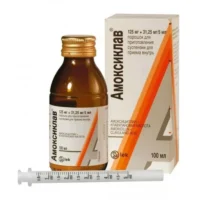Description
Doxiciclin-TEVA (Doxycycline) Tablets 100 mg. №10
Composition
Active Ingredient: Each tablet contains Doxycycline 100 mg.
Mechanism of Action
Pharmacological Properties: Doxycycline exerts its antibiotic effect by inhibiting bacterial protein synthesis, leading to the suppression of bacterial growth and multiplication. It has broad-spectrum activity against gram-positive and gram-negative bacteria, as well as certain other microorganisms.
Indications for Use
Indications: Doxycycline is indicated for the treatment of various infections caused by susceptible strains of bacteria. It is commonly used to manage respiratory tract infections, urinary tract infections, skin infections, and other bacterial conditions.
Contraindications
Contraindications: This medication should not be administered to individuals with a known hypersensitivity to doxycycline or other tetracyclines. Caution is advised in patients with a history of liver or kidney impairment.
Side Effects
Side Effects: Common side effects of doxycycline may include nausea, vomiting, diarrhea, abdominal pain, and skin sensitivity to sunlight. Serious but rare side effects may include severe skin reactions, liver problems, and intracranial hypertension.
Usage Instructions
Usage: The typical dosage ranges from 100 mg to 200 mg daily, divided into two or more doses. It is essential to follow the prescribed regimen strictly and not exceed the recommended dosage without medical advice.
Advantages Over Analogues
Doxiciclin-TEVA offers the advantage of a well-established safety profile and efficacy in the treatment of various bacterial infections. Compared to some other antibiotics, doxycycline exhibits a broader spectrum of activity and is effective against a wide range of pathogens.
Suitable Patient Groups
Due to its safety and efficacy profile, doxycycline is suitable for use in diverse patient populations, including adults, elderly individuals, and pediatric patients above a certain age determined by the healthcare provider.
Storage and Packaging
Storage: Store at controlled room temperature away from moisture and light. Keep the medication out of reach of children.
Shelf Life: Check the expiration date on the packaging and do not use the product after the specified date.
Packaging: The product is supplied in blister packs containing 10 tablets each, ensuring convenience and protection from environmental factors.
Clinical Evidence and Effectiveness
Scientific Evidence: Doxycycline has been extensively studied for its efficacy in treating various infections. Clinical trials and research, such as studies published in reputable journals like the Journal of Antimicrobial Chemotherapy and the International Journal of Infectious Diseases, have demonstrated the effectiveness of doxycycline in combating bacterial infections.
Proven Effectiveness: Clinical studies have shown that doxycycline is highly effective in the management of respiratory tract infections, urinary tract infections, skin infections, and community-acquired pneumonia. The antibiotic’s broad-spectrum activity and favorable safety profile make it a valuable option in the therapeutic arsenal against bacterial pathogens.





